Like many owls, snowy owls are also carnivorous meaning they are predatory birds eating meat. However, snowy owls live in the harsh environment of the Arctic tundra where food is scarce, so what exactly could they eat there?
Snowy owls’ favorite food is small rodents, especially lemmings. During the breeding season of snowy owls in the Arctic tundra their main prey is the highly abundant lemming. However, on some occasions, in different localities and out of their breeding habitat, snowy owls are also seen hunting down ducks, fish, and even hares.
Keep reading if you want to find out what hunting techniques snowy owls use to catch their food and how they eat it.
Is A Snowy Owl A Carnivore?
The snowy owl is a carnivorous animal whose primary food source is small mammals. Snowy owls are opportunistic hunters adapting to feed on whatever is available. This can include seabirds, fish, and squirrels.
However, in the Arctic tundra, their preferred prey are lemmings. The abundance of these hamster-like rodents defines the snowy owl movement, making them nomadic birds.
Being nomadic birds means that every year the snowy owls may be found in different parts of the Arctic and sub-Arctic tundra according to the lemming populations which vary in space and time.
Despite being meat eaters, snowy owls do not have huge predator teeth. Instead, they use their sharp beaks to rip into pieces their prey or if it’s small enough they even swallow it whole1 (source: American Bird Conservancy).
There are parts of the prey that the owl can’t digest when it’s swallowed whole, such as bones, feathers, and fur. Those collect in the stomach and form a pellet which the bird throws up when it gets too big. Although it may sound a bit gross, these pellets are very important for scientists. Thanks to them they can have a detailed insight into the diet of the snowy owls. For example, people have even found wool in a pellet from a snowy owl suggesting it has eaten a dead sheep2 (source: E. Potapov and R. Sale, The Snowy Owl, 2013).
What Do Snowy Owls Eat?
Snowy owls mostly eat rodents such as lemmings. However, they are also known to eat ducks, fish, and hares. When their chosen food is unavailable, they have been known to eat many other animals including rabbits, squirrels, salamanders, and even other owls.
Here is a breakdown of their main food groups.
1. Lemmings
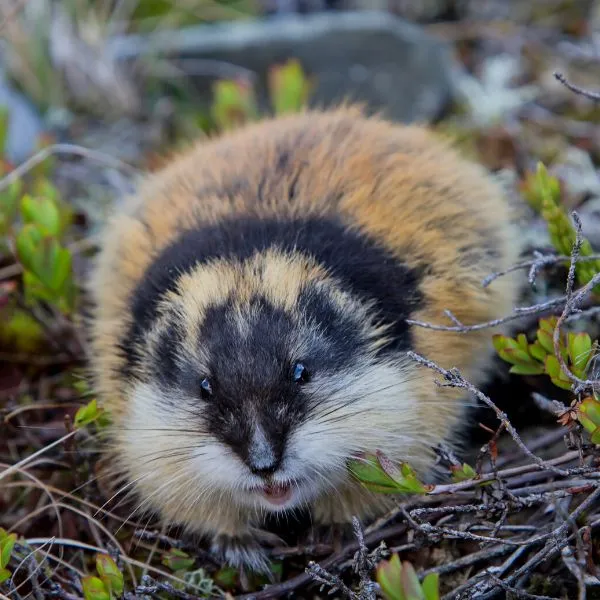
The preferred prey of snowy owls are lemmings, especially during the bird’s breeding season in the Arctic tundra. Lemmings are small rodents that feed on vegetation like roots, moss, and grass.
Lemmings are one of the most abundant rodents in the Arctic and sub-Arctic tundra together with voles. Small mammals like lemmings, voles, and mice are easy targets for snowy owls. They require minimum effort for snowy owls to catch compared to flying birds.
Snowy owls like eating large-sized lemmings which change their abundance in a cyclic way across time and space. This makes snowy owls go wherever the population of lemmings has the highest density3 (source: E. Potapov and R. Sale, The Snowy Owl, 2013).
2. Ducks and Other Birds

The diet of snowy owls consists of birds during the non-breeding season when there are no small rodents abundant.
On multiple occasions, snowy owls are seen to consume different types of ducks. For example, in the Belcher islands, Canada and other parts of the Arctic, wintering sea ducks are important food for snowy owls. Particularly common eiders and long-tailed ducks (shown here).
During the winter snowy owls move to more coastal areas where there are plenty of seabirds to prey upon. Parts of gulls, murrelets, and guillemots were found in pellets discharged by snowy owls showing they feed on them.
Snowy owls are also seen to feed on pheasants in southern Canada and pigeons around Massachusetts. These unusual targets for snowy owls are showing that when there is a limited food source the white owls would eat anything available even if that means flying through a city4 (sources: G. J. Robertson and H.G. Gilchrist, Journal of Raptor Research, Vol. 37(2). 2003, pp.164-166 and P. L. Williams and L. G. Frank, The Cooper Ornithological Society, 1979).
3. Hares and Rabbits

Snowy owls are also seen to feed on hares and rabbits. Although their main prey are small rodents, in some regions rabbits and hares are also considered an important food source for snowy owls. For instance, such localities are Pennsylvania and Maine. They are also known to eat arctic hares.
Despite being recorded in a very low percentage, snowy owls spending the winter in Michigan have cotton-tailed rabbits as part of their diet5 (source: A. O. Gross, A Quarterly Journal of Ornithology. Vol. 61, 1944).
4. Other Animals
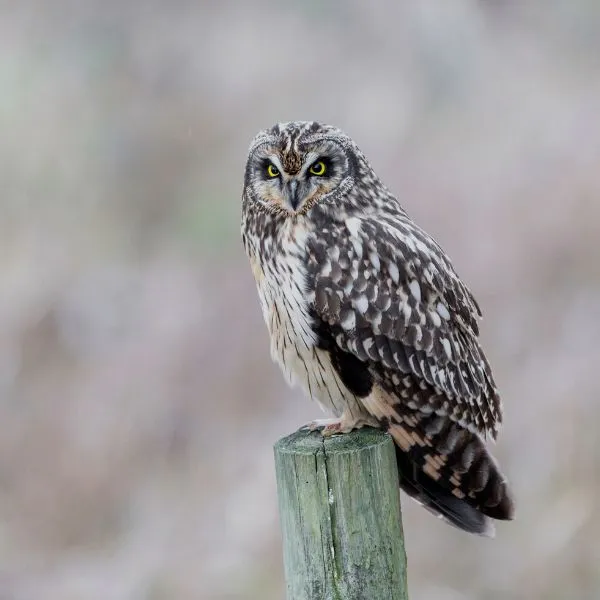
Snowy owls are seen to prey on all kinds of random animals when there aren’t sufficient lemmings or small rodents are not abundant at all.
An example of unusual predation by snowy owls is hunting other owls such as the small short-eared owl (shown here). Snowy owls are seen to consume grouse and short-eared owls in the later stages of the breeding season when there are a lot fewer lemmings available.
Snowy owls choose the prey which is more cost effective and requires less energy to catch. Often the nests of small owls are easier to hunt rather than a flying grouse.
Other bizarre animals as part of the diet of snowy owls are fish, squirrels, salamanders, and even an occasional frog6 (source: A. O. Gross, A Quarterly Journal of Ornithology. Vol. 61, 1944).
How do Snowy Owls Eat?
Hunting techniques used by snowy owls depend on snow cover. Most often snowy owls catch their prey through the technique of sit-and-watch and this is usually from a high point with a good overview of the landscape.
On some occasions, snowy owls hover in the air while hunting or walk on the ground looking for prey.
Despite being patient hunters, snowy owls are very fierce and responsible when it comes to protecting their nest, so they can’t risk being away from it for a long time without supervising it.
For snowy owls, just like most owls, good vision and hearing are very important tools to detect food. These qualities are very helpful for providing food to the newborn chicks while also being close by to protect them.
Snowy owls, just like other birds, don’t have sharp teeth and cannot chew their food. However, they use their hooked beaks to break the skulls of their prey and rip them into pieces.
When the prey is small enough, such as small lemmings and mice, snowy owls swallow them whole. They do this by taking the animal head first into their surprisingly big mouths.
The parts of the prey that the snowy owl cannot digest collect in the form of a pallet. This pallet consists of fleshless bones covered in fur. Snowy owls regurgitate these pallets once they are big enough and start hurting their stomachs.
Pellets discharged by owls are incredibly valuable to scientists because their contents give them exclusive knowledge on the bird’s diet7 (sources: British Birds, Vol. 79: pp. 228-242, 1986 and American Bird Conservancy).
How Much Do Snowy Owls Eat?
Owls are generally a nocturnal animal that hunts during the night. Snowy owls are no exception. They are most active at night during the winter.
However, in the summer the days in the high latitudes of the Arctic can be up to 24 hours long. That doesn’t leave a choice to the snowy owls but to hunt in daylight.
The preferences of snowy owls for hunting differ across the regions they inhabit. For example, snowy owls in Greenland are feeding in the early morning or late afternoon. Whereas in Shetland during the winter snowy owls are eating in the evening and spend the day asleep.
In a year a snowy owl can eat more than 1600 of their favorite rodents. Typically, a snowy owl would consume between three and five lemmings a day. However, snowy owls store fat from the good days so when lemmings are deficient they can go up to 40 days without feeding8 (sources: D.S. Miller, Arctic Lights, Arctic Nights, 2007 and A. Watson, IBIS, Vol. 9, Issue 3, 1957, pp. 419-462).
Related Questions
Do Snowy Owls Eat Arctic Foxes?
Yes, snowy owls can eat Arctic foxes. Occasionally, parts of Arctic foxes are found in the pellets discharged by snowy owls. Despite the fact that the two predators are competing for the same prey, they also eat each other.
Does A Snowy Owl Eat Plants?
No, snowy owls do not eat plants. Snowy owls can’t eat plants with their beaks neither they can swallow nor directly digest vegetation.
Snowy owls get the nutrients that plants provide through eating lemmings. Lemmings and other rodents are secondary producers being entirely vegetarian.
Do Snowy Owls Eat Fish?
Yes, snowy owls eat fish in the coastal areas they inhabit. They are seen to use the holes cut in the ice by fishermen to catch fish.
Do Snowy Owls Eat Penguins?
No, snowy owls do not eat penguins because there are no penguins in the Arctic. Penguins are aquatic seabirds that live only in the Southern Hemisphere and the habitat of the snowy owls is in the northern latitudes9 (source: P. D. Boersma and P.G. Borboroglu, Penguins: Natural History and Conservation, 2015).
Do Snowy Owls Eat Caribou?
We cannot confidently say if they definitely do not eat caribou because no records were found. After all, when food is scarce snowy owls feed on what is available and if that is an injured or dead caribou, probably there is a chance a hungry snowy owl would eat it.
Do Snowy Owls Eat Arctic Hares?
Yes, snowy owls can eat arctic hares. Although hares are not their preferred food, snowy owls do hunt them on some occasions when small mammals are insufficient.
Do Snowy Owls Eat Rabbits?
Yes, snowy owls eat rabbits. In fact, cotton-tailed rabbits are an important food source for snowy owls in some regions such as New England and Pennsylvania10 (source: A. O. Gross, A Quarterly Journal of Ornithology. Vol. 61, 1944).
What Are The Predators Of The Snowy Owl?
The predators of snowy owls can be various. The most obvious ones are the Arctic foxes but they are also preyed upon by a smaller family of carnivorous mammals which includes badgers, minks, and weasels.
Surprisingly, snowy owls are also hunted by a predatory seabird – the skua11 (source: E. Potapov and R. Sale, The Snowy Owl, 2013).


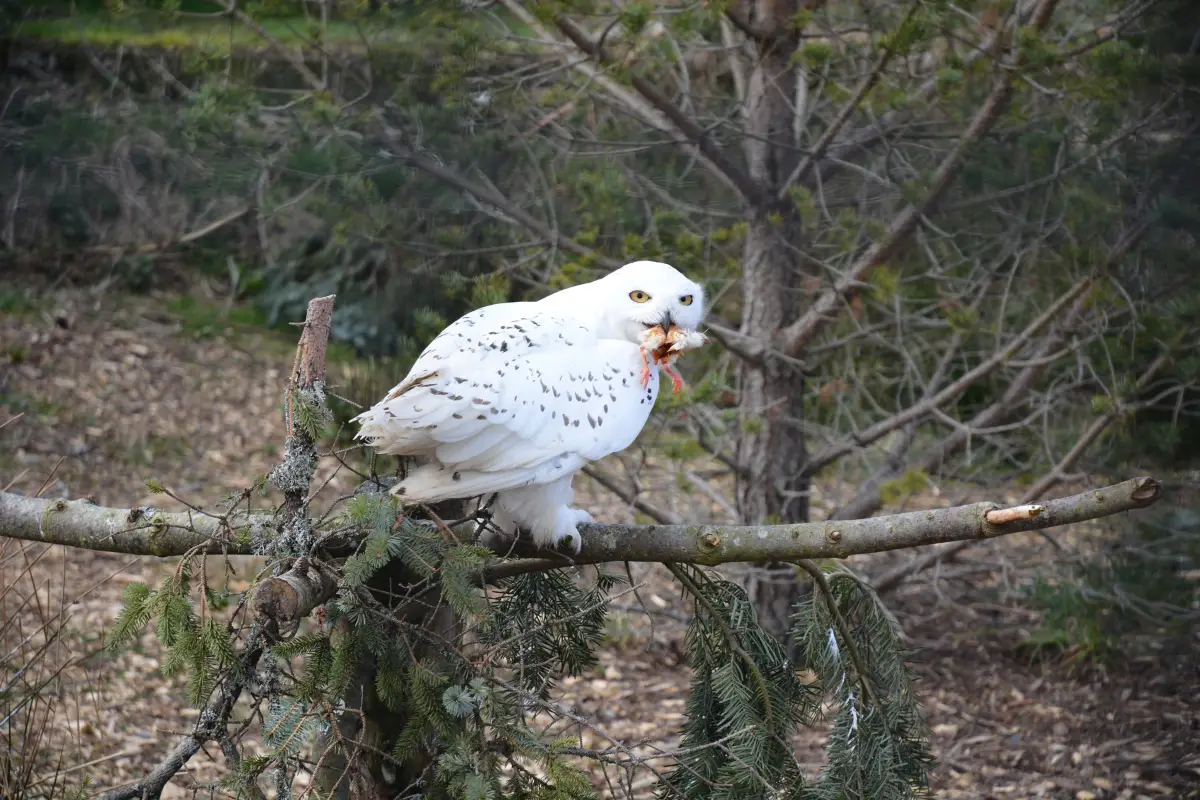
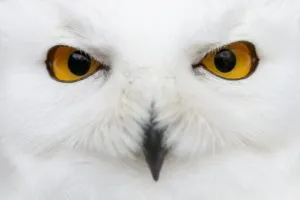
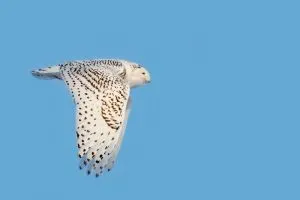
![Read more about the article Are Snowy Owls Nocturnal? [Sleeping Habits Revealed]](https://polarguidebook.com/wp-content/uploads/2023/01/Snowy-Owl-Closeup-300x200.jpg)